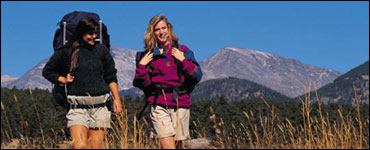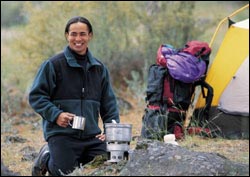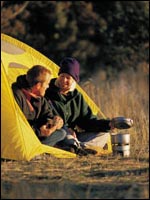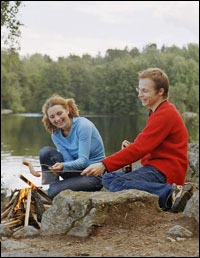CDC Features
Current Features
Have a Safe and Healthy Camping and Hiking Experience

Fall is an ideal season for camping and hiking. Over 15 million outdoor enthusiasts participate in activities such as hiking and mountain biking. Nearly one-third of adult Americans reported taking a camping vacation within the last 5 years, according to the Travel Industry Association of America.
If you're heading outdoors this fall, take a cue from the Scouts and be prepared. We've listed a series of outdoor health and safety risks and what to do about them. With proper preparation and safety precautions, every camping trip and outdoor activity can be a fun, safe, and healthy one.

Be prepared and alert for health and safety risks:
• Carbon monoxide poisoning
• Animal encounters
• Campfire safety
• Sunburn
• Bug bites
• Scrapes and scratches
• Questionable drinking water
Carbon Monoxide Poisoning

Carbon monoxide (CO) is an odorless and invisible gas produced
by normal combustion. CO in an open area is not harmful. However,
incomplete combustion of fuel greatly increases the production
of the poisonous gas. In enclosed spaces, CO is extremely harmful
and even deadly. Annually, thousands of people are poisoned through
CO exposure.
To protect yourself from CO when camping, keep your portable gas stove
or heater outside and well away from the tent. To keep warm on cold evenings,
pack warm clothing and extra blankets. Make sure gas lamps are off when
you go to sleep. See You Can Prevent Carbon
Monoxide Exposure.
Be alert to the most common symptoms of CO poisoning: headache, dizziness,
weakness, nausea, vomiting, chest pain, and confusion. High levels of CO
inhalation can cause loss of consciousness and death. People who are sleeping
or intoxicated can die from CO poisoning before ever experiencing symptoms.
If you suspect CO poisoning, get fresh air and seek prompt medical attention.
Animal Encounters
Be safe by keeping your distance from wildlife you encounter while on a camping trip or hike. Do not handle, feed, or unintentionallym attract wild animals with open garbage cans or litter. Do not bring wild animals into your tent or trailer, and do not try to nurse sick animals to health. Some diseases that infect animals can cause illness in people. These diseases, called zoonoses, can be dangerous and include rabies, histoplasmosis, hantavirus, and tularemia. Recognize the danger of diseases from wildlife and enjoy wildlife from a distance.
Campfire Hazards

The traditional end to a camping day is a campfire. Following simple fire safety rules can prevent a smoldering ember from becoming a wildfire. Sixty-plus years after his creation by USDA Forest Service, National Association of State Foresters, and the Ad Council, Smokey [the] Bear still offers simple wildfire prevention rules:
1. Dig a small pit away from overhanging branches. (Most parks have campfire pits ready and waiting for you.)
2. Circle the pit with rocks or be sure it already has a metal fire ring.
3. Clear a five-foot area around the pit down to the soil.
4. Keep a bucket of water and a shovel nearby.
5. Stack extra wood upwind and away from the fire.
6. After lighting, do not discard the match until it is cold.
7. Never leave a campfire unattended, not even for a minute.
For additional informaton on campfires, see Smokey Bear's Seven Campfire Safety Tips*
Other Possible Outdoor Risks

Sunburn
Spending time outdoors means spending time in the sun. Consistent protection from sun exposure —all year round —is important on cloudy and hazy days, as well as bright and sunny days. To prevent burning, follow these sun protection practices. If you're outside with children, see Play it Safe in the Sun: A Guide for Parents.
Bug Bites
The best defense against bug bites is to use insect repellent containing an EPA-registered active ingredient (DEET, picaridin, or oil of lemon eucalyptus) and follow the directions on the package. Wear long sleeves and pants when possible. Learn more about protection from mosquitoes and Fight the Bite!. To reduce your risk for tick-borne diseases, follow these tips and Stop Ticks.
Scrapes and Scratches
Blisters, scratches, and scuffed knees are common on a hiking trail, so bring items necessary to clean and, if necessary, bandage them. Prompt treatment can help prevent infection and promote healing. Your backpack should hold first aid supplies that you might need if someone gets hurt.
Questionable Drinking Water
Bring bottled water from a trusted source on your hike or purify water from a lake or stream near your campsite. Boiling water is the best method for making local water safe to drink. You may add a pinch of salt to each quart to improve the taste. Chemical disinfection with iodine is another method for purifying water; see Treatment of Drinking Water.
Additional Resources
- Backpacking
and Camping (English) (
 3
pages, 2.24 MB)
3
pages, 2.24 MB) - Backpacking
and Camping (Spanish) (
 3
pages, 1.65 MB)
3
pages, 1.65 MB) - Camping
Days Coloring Page (
 1
page, 1.19 MB)
1
page, 1.19 MB)
Page last updated: October 8, 2007
Content source: National Center for Environmental Health,
National Center for Preparedness, Detection, and Control of Infectious Diseases,
and National Center for Zoonotic, Vector-Borne, and Enteric Diseases.
Content owner: National Center for Health Marketing
URL for this page: www.cdc.gov/Features/OutdoorSafety
*Links to non-federal organizations are provided solely as a service to our users. These links do not constitute an endorsement of these organizations or their programs by CDC or the federal government, and none should be inferred. CDC is not responsible for the content of the individual organization Web pages found at these links.

